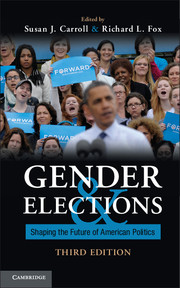Book contents
- Frontmatter
- Contents
- List of Figures, Text Boxes, and Photos
- List of Tables
- Contributors
- Acknowledgments
- Introduction
- 1 Presidential Elections
- 2 Cracking the “Highest, Hardest Glass Ceiling”
- 3 Voter Participation and Turnout
- 4 Voting Choices
- 5 Latinas and Electoral Politics
- 6 African-American Women and Electoral Politics
- 7 Congressional Elections
- 8 Political Parties and Women's Organizations
- 9 Advertising, Websites, and Media Coverage
- 10 Women's Election to Office in the Fifty States
- Index
- References
1 - Presidential Elections
Gendered Space and the Case of 2012
Published online by Cambridge University Press: 05 June 2014
- Frontmatter
- Contents
- List of Figures, Text Boxes, and Photos
- List of Tables
- Contributors
- Acknowledgments
- Introduction
- 1 Presidential Elections
- 2 Cracking the “Highest, Hardest Glass Ceiling”
- 3 Voter Participation and Turnout
- 4 Voting Choices
- 5 Latinas and Electoral Politics
- 6 African-American Women and Electoral Politics
- 7 Congressional Elections
- 8 Political Parties and Women's Organizations
- 9 Advertising, Websites, and Media Coverage
- 10 Women's Election to Office in the Fifty States
- Index
- References
Summary
The election of 2012 began November 5, 2008, the day after the 2008 election. While certain features, such as the presence of an incumbent, may make elections seem similar, every presidential campaign is a product of current circumstances, the prior election cycle, the party in power, and other variables. While the presence of Republican incumbent George W. Bush focused attention on the Democratic field in 2004, the presence of Democratic incumbent Barack Obama in 2012 placed the spotlight on the Republican field of candidates. Also and importantly, the Republican sweep in the 2010 congressional elections, driven by the Tea Party phenomenon, set the stage for 2012. In contrast, the 9/11 attacks figured prominently in the 2004 election. In both election cycles, gender – particularly masculinity – was central, and it remains an unspoken assumption in presidential elections.
In fact, shortly after the 2004 election, a tongue-in-cheek Associated Press (AP) article led with the following: “Wanted: a former altar boy from the Southwest who speaks Spanish, married into a rich Republican family from Ohio and revolutionized the Internet after working as a volunteer firefighter in Florida. Position: president of the United States.” Using findings from exit polls to construct the profile of the perfect presidential candidate for 2008, the article went on to propose that he:
“[is] a Medal of Honor winner” with combat experience, who helped normalize relations with Vietnam
loves outdoor sports and drops his “‘g's’ when talkin’ about huntin’ and fishin’ and car racin’”
is a former quarterback for the University of Michigan Rose Bowl team
is a “trained economist who taught in Minnesota, where he met his wife, a nurse,” whose father is a former governor
“was a volunteer fireman” who “drove his pickup truck to help out the World Trade Center site”
and is “a billionaire in his own right who developed software…”
- Type
- Chapter
- Information
- Gender and ElectionsShaping the Future of American Politics, pp. 16 - 48Publisher: Cambridge University PressPrint publication year: 2013



